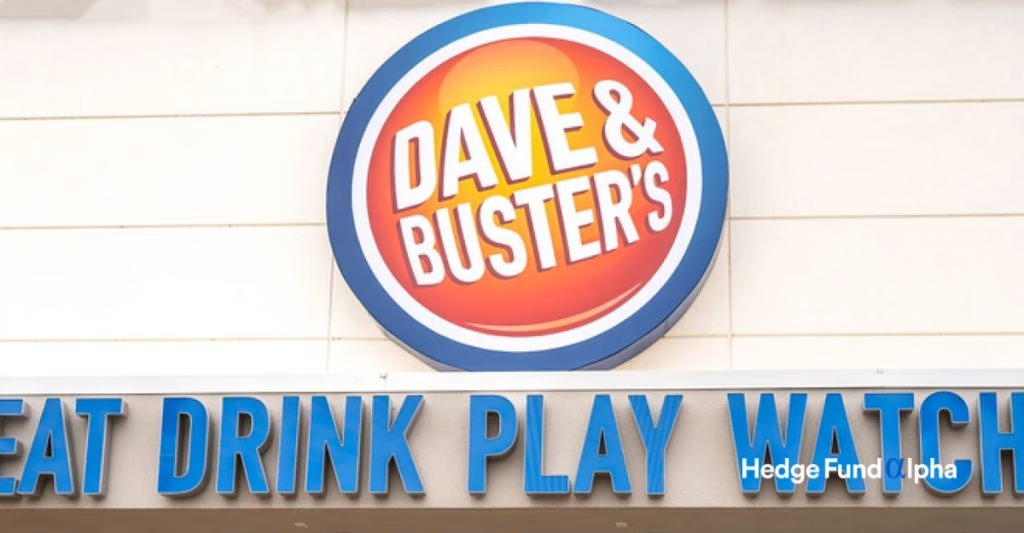RGA Investment Advisors' commentary for the second quarter ended June 30, 2024.
Much has happened since the end of the second quarter, but it’s valuable to reflect on the key events that shaped those three months. In years to come, we may view the first half of June as a pivotal moment for Large Cap stocks, particularly the dominance of the “Magnificent 7” over the broader market. Among these, NVIDIA Corp’s (NASDAQ:NVDA) performance stood out, becoming the driving force within the group. Throughout the trading days, NVIDIA’s movements often dictated the direction of the major market indices, with its rise (or fall) pulling the broader market up (or down) with it. As the largest company in the S&P 500, NVIDIA’s influence lifted the index, while the Russell 2000 lagged behind. This trend is best understood when visualized:
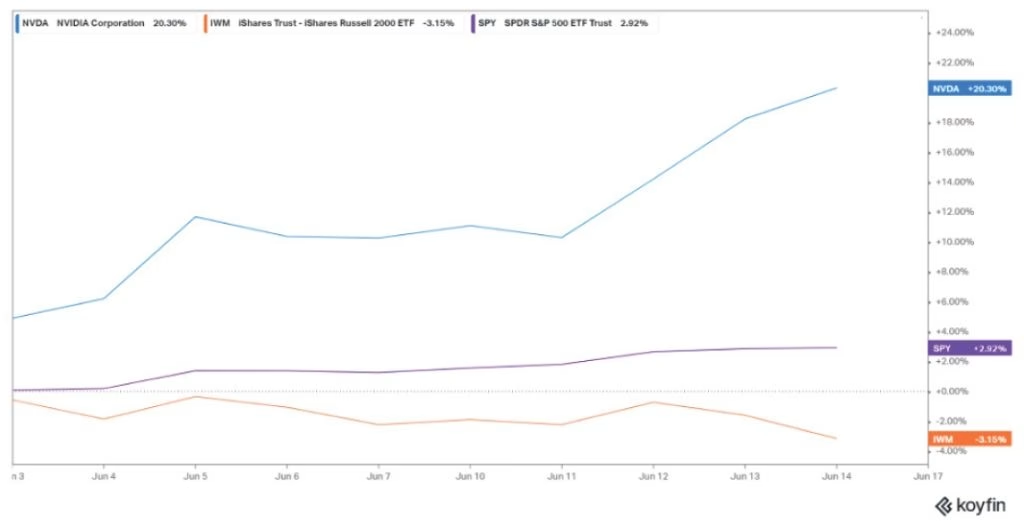
Hedge fund letters, conferences and more
Clearly, we were too early in anticipating some catch-up performance for small caps relative to large caps. However, as is often the case in markets, these shifts turn into a frenzy rather than a slow grind just before the momentum swings in the opposite direction. Already in the third quarter, we observe signs of a turnaround in small caps relative to big caps, though we will withhold further commentary until our next update. The key point here is that, in many ways, Large Cap dominance felt like a gradual build leading into a blow-off top during the second quarter.
POSITION UPDATES
Sartorius AG (ETR:SRT)
Continuing the theme of being too early, in our Q1 commentary, we mentioned initiating a position in Sartorius during the quarter and adding more in early Q2. Following the company’s Q1 report, an investor day, and an analyst appearance, management hinted that meeting the year’s guidance would be challenging. This resulted in a swift decline in the share price; however, it’s important to note that despite the company’s overly ambitious guidance at the beginning of the year and subpar communication, the bioprocessing industry continues to demonstrate that the post-COVID bottom is indeed firmly established, and the inflection point has begun. While there is debate over how quickly the industry will return to normalized growth rates, we firmly believe that the structural growth remains unchanged and, as a result, our long-term returns from our cost basis will likely be consistent, if not better, than our initial expectations.
NEW POSITIONS
Dave & Buster's Entertainment Inc (NASDAQ:PLAY)
Dave & Buster’s has so far been a story of being both too late and too early. We had done extensive research on this name during the second half of last year and felt we missed the opportunity as the stock rose from the low $30s to nearly $70 per share. When prices pulled back to $50, we saw a second chance to get in at what we believed to be attractive prices, with strong valuation support. In the near term, we have clearly been wrong, though we believe the shares are incredibly compelling at this level.
The biggest problem for the stock in this brief time since our purchase has been the retrenchment of low-income consumers. This is a macro company ailing the entire restaurant space and numerous consumer-centric companies beyond Dave & Busters. In the June call, management mentioned that “One of the trends that we’ve noticed in the business that we discussed last quarter was on our lower-income consumers, there was more weakness within lower-income consumers versus moderate-income and high-income and we saw some strengthening in the higher income last quarter.”
We view this is a macro phenomenon, perhaps in part caused by the high inflation of the past few years and the accompanying aggressive monetary tightening from the Federal Reserve. Importantly, between meaningfully lower oil prices and forthcoming rate cuts, relief is in sight and the low-income consumers are the most likely to quickly turn oil and interest rate savings into discretionary spend. A trip to Dave & Busters is one of the most affordable entertainment offerings for a family, as was nicely presented in this slide from the company’s investor day:
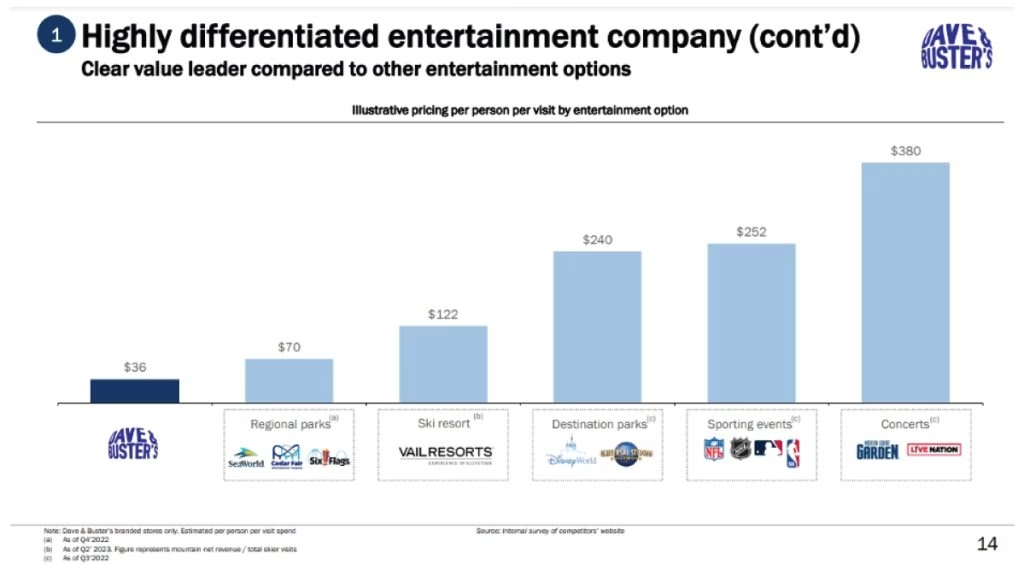
The largest owner of Dave & Buster’s is Hill Path Capital, a team that originated from Apollo Management’s private equity group, specializing in lodging, entertainment, and gaming. This is the same team that led a highly successful turnaround at SeaWorld Entertainment (now United Parks & Resorts Inc (NYSE:PRKS)).
Much of the toolkit from the SeaWorld turnaround, including enhanced marketing and pricing strategies informed by data, applies in the case of PLAY. Unlike SeaWorld, which suffered considerable public opinion fallout in the wake of the Blackfish documentary, Dave & Busters required no such turnaround, merely better operations. At PLAY, Hill Path took two board seats and orchestrated a takeover of a similar entertainment concept–Main Event–and installed the Main Event management team and other new leaders at the top of PLAY.
The new management team shared a detailed Investor Day presentation in June of 2023 that outlined “six levers” that would lead to an incremental $430-600 million in EBITDA:
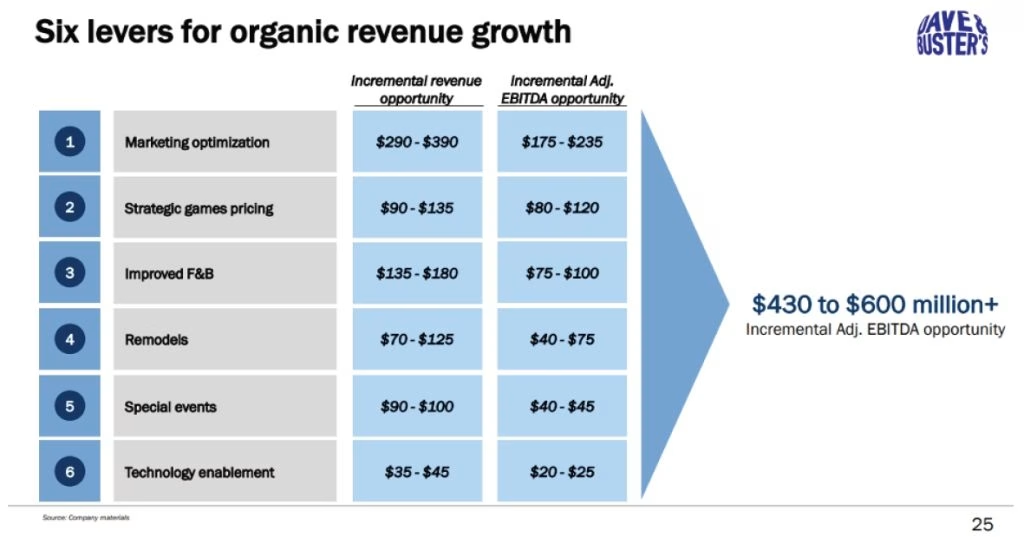
Four of the key strategic pillars in particular drive our enthusiasm:
- “Marketing optimization”—old management relied almost exclusively on linear TV broadcasting, which was a mismatch with the audience, was difficult to measure, and led to little results. New management relies heavily on digital advertising and is building a loyalty program and email file to take advantage of customer engagement.
- “Strategic games pricing”—PLAY had an unsophisticated pricing model, whereby the same game cost the same for a visitor irrespective of the geographic location or time of day. This makes little sense, as markets with higher cost of living should have higher game prices than elsewhere. Moreover, there are opportunities around changing game pricing based on time of day or week.
- “Improved F&B”—in some respects, this might be the largest opportunity. In 2023, from pre-COVID, amusement revenue per box was up 9.4%, whereas Food and Beverage revenue was down 16.94%. Were F&B revenue merely indexed to inflation alone, it would be 34% higher. The problems stem from lower attach rates to F&B (i.e., more people coming for amusement alone), a misfit menu due to prior management installing a chef far too focused on broadening the menu a la Cheesecake Factory, and an unwillingness to push price. A new, simplified, and appropriate menu should solve all these problems.
- “Special Events”—in our eyes, this is the highest probability fix. During the COVID shutdowns, the company’s revenue base was hard hit, and consequently, prior management took appropriate defensive actions to preserve their balance sheet and ability to operate. As COVID moved into the rearview mirror, management was slow to add back key staff and, instead of restaffing events with managers locally, kept a call-center-based team to handle event bookings. As a result, events never recovered post-COVID, meanwhile events formerly had been a nice driver of profitability, with good F&B attach rates and profitable gaming. New management is restaffing events locally and properly incentivizing managers at each box to build demand and appropriately support event organizers.
With these key strategic pillars, an opportunity to grow the box footprint at a mid-single-digit pace per year, and an increasingly obvious value proposition for the typical family, PLAY looks incredibly appealing today at its mid-single-digit EBITDA multiple. One problem ailing the stock is that management is undertaking a large remodeling plan, which has led free cash flow to diverge from EBITDA. Two years ago, the free cash flow yield was in the double digits on today’s valuation, but today, it is crimped. As these investment initiatives roll off over the next two years, free cash flow will once again converge with EBITDA, and if the initiatives management is taking are at all successful, the free cash flow yield will be considerably higher. Management targets $1 billion in EBITDA by 2026 for a company with a $1.2 billion market capitalization.
In hindsight, we wish we waited a mere two months to commence our position, though over time, we think the valuation and opportunity look very compelling. One opportunity out of this recent swoon stems from the company’s aggressive share repurchase policy. All incremental free cash flow (as well as the cash from strategic moves like sale-leasebacks on their owned stores) is getting deployed into share repurchases. Fully diluted shares outstanding are down 17.2% since their peak in 2022 and will continue to decline over time. As unit-level sales stabilize and the business gets back to healthier growth, this will inevitably create more value as the company strives towards the $1b EBITDA goal.
Repurchased Vail Resorts, Inc. (NYSE:MTN)
We followed Vail for many years and finally bought shares when the entire world was locked down, unsure what this mysterious new COVID virus might do. Just over a year later, we sold our shares. Although we moved on, we continued to follow the company closely. Vail owns and operates some of the most irreplaceable assets in the world–ski mountains–blessed with some of the finest locations to capture natural snow and the most scaled player to invest in man-made snow at the lowest cost in the industry, where appropriate. For the foreseeable future, it is unlikely any new ski mountains will open again. In fact, the number of active mountains has been declining for decades. That places Vail in a special position, both in terms of the ability to command skier visits and to underwrite for a very long duration on their prized assets.
On the heels of an incredibly challenging snow season and questions about overcrowding amidst staffing shortages, shares hit their lowest valuation in a decade, at which point we once again commenced a position:
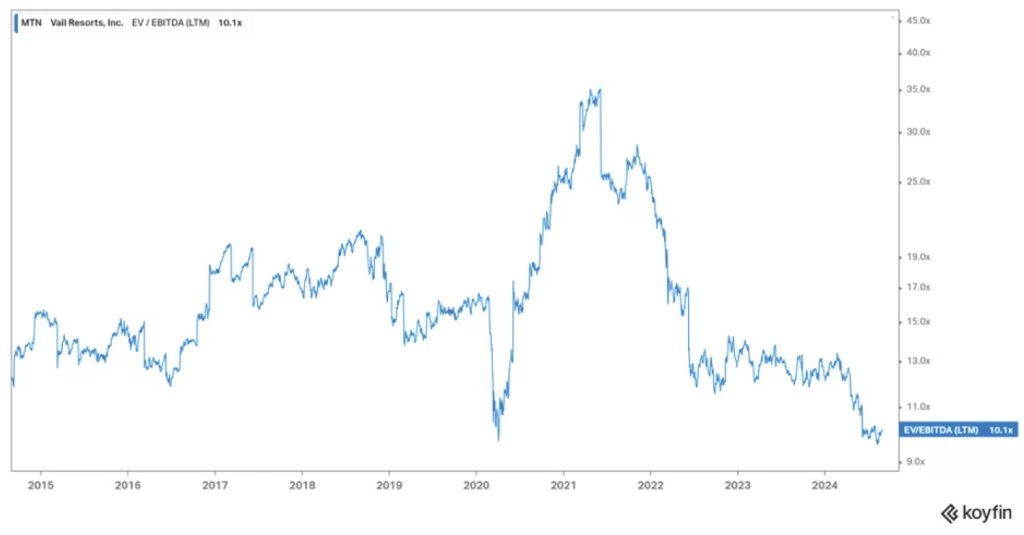
Vail itself seems to recognize this cheapness, as the company repurchased more shares in the last year ($500 million) than it had cumulatively over the prior 20 years (~$480 million). This is notable for a company which has generally repurchased with prudence and astute timing (the most meaningful share repurchase in the last 20 years came in 2008, with nearly $100 million worth).
Vail was effectively re-founded by Robert Katz, who led the ski industry into the multi-mountain pass business. The pass drastically reduced pricing for full-season skiers, thus making mountain access more affordable and shifting the seasonal vicissitudes of unpredictable snow to pass holders from the mountain resorts themselves. Skiing is not merely an activity, but a lifestyle for the sport’s participants, and the past business has turned the relationship into an irreplaceable subscription service. This is acceptable to skiers, as the lower price of a pass and a deep portfolio help skiers themselves offset the snow risk. If snow is light in Colorado, then they can simply shift their planned travel to Tahoe, or vice versa. It is a true win/win relationship for customers and the business alike.
Although Vail has suffered some recent challenges, we are confident the company will work through them. A substantial wage increase last year crimped margins, but restored service quality. CAPEX that had been postponed during COVID resumed and the company has come a long way towards easing key bottlenecks at prominent mountains. Snow was lackluster early last year, but strong at the end of the year which re-excites skiers for the coming year. At these prices Vail boasts a 5% dividend yield, mid-single digit growth due to a combination of pricing, increased Epic pass penetration and modest demographic support. Beyond this, we expect Vail to continue its acquisition strategy, with the opportunity to build out a more robust pass network in Europe and enhance its U.S. presence by densifying under-exposed regions.
IN SUM
We continue to find the opportunity set compelling. Most recently, consumer-facing companies have been in the market’s crosshairs, as evidenced by the two new positions we commenced this past quarter. Although much of the past year in these commentaries has focused on the life sciences, we are increasingly comfortable with our allocation to the space and focused on some high-quality assets that are cyclically suffering from tightening wallets with consumers, but positioned to prosper longer-term when the environment once again normalizes.
Thank you for your trust and confidence, and for selecting us to be your advisor of choice. Please call us directly to discuss this commentary in more detail – we are always happy to address any specific questions you may have. You can reach Jason or Elliot directly at 516-665-1945. Alternatively, we’ve included our direct dial numbers with our names below.
Warm personal regards,
Jason Gilbert, CPA/PFS, CFF, CGMA
Managing Partner, President
Elliot Turner, CFA
Managing Partner, CIO
RGA Investment Advisors

